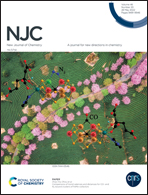The fabrication of a highly electroactive chiral-interface self-assembled Cu(ii)-coordinated binary-polysaccharide composite for the differential pulse voltammetry (DPV) detection of tryptophan isomers
Abstract
It is of significance to fabricate excellently performing chiral carbon nanocomposites for chiral electrochemical detection applications. Herein, a self-assembled Cu(II)-coordinated dual-polysaccharide composite (CD-Cu-CMC) has been synthesized via electrostatic interactions between Cu(II)-coordinated β-cyclodextrin (Cu-β-CD) and sodium carboxymethyl cellulose (CMC), overcoming the limitations of polysaccharide agglomeration, and a substrate material (rGO-PANI) was prepared from graphene and aniline via persulfate-initiated polymerization. Combining the advantages of the base material (rGO-PANI) and the chiral selector (CD-Cu-CMC), a novel chiral carbon nanocomposite (rGO-PANI/CD-Cu-CMC) was successfully synthesized via a Cu–N self-assembly method. The enantioselectivity of rGO-PANI/CD-Cu-CMC/GCE toward tryptophan (Trp) enantiomers was shown via differential pulse voltammetry (DPV). The results indicated that rGO-PANI/CD-Cu-CMC/GCE showed a higher electrochemical signal in response to L-Trp than D-Trp.



 Please wait while we load your content...
Please wait while we load your content...